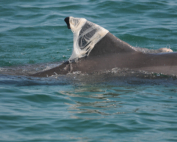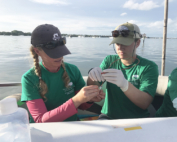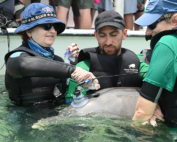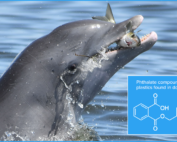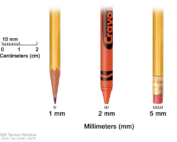How Can Plastic Pollution Impact Dolphins?
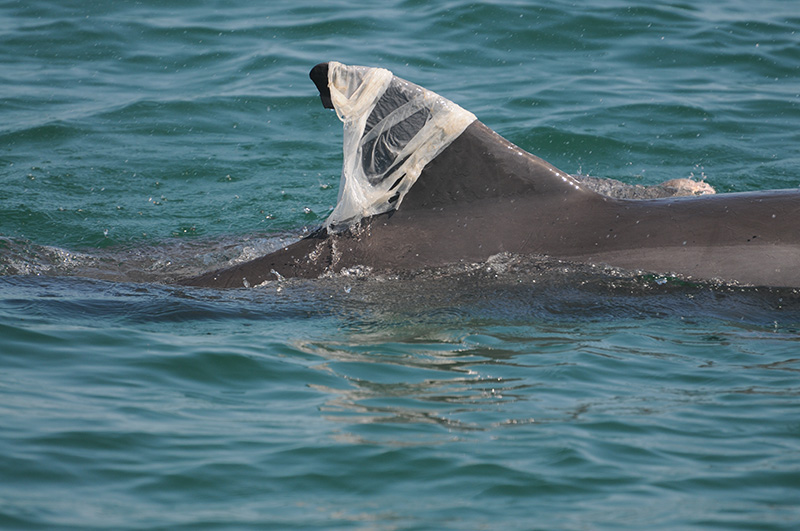
Worldwide, humans use an estimated 100 billion plastic bags every year; the average American uses more than 300, according to Environment America. All told, the U.N. Environment Program estimates that humans produce more than 400 million metric tons of plastic annually.
That’s a lot of plastic — and a lot of it is ending up in the ocean (170 trillion plastic particles, according to this study), where it impacts marine life in a variety of negative ways:
- Plastics, including braided micro-multifilament fishing line, can cause entanglements that lead to marine animal injuries and deaths (see a few examples of the entangled dolphins we’ve rescued here).
- Animals can accidentally eat plastic because they mistake it for food or swallow it while eating other things. New research shows that plastic is everywhere in the food chain, and predators can eat plastic without knowing it when they catch their usual prey. Large plastic items can cause stomach or intestinal blockages, which can lead to starvation and death.
- Emerging studies have also revealed that bottlenose dolphins inhale microplastics, or small plastic particles <5 mm in diameter.
- When plastics break down in the environment, they can release chemicals called phthalates. In humans, these chemicals can impact reproduction, growth, and development. They can also cause problems with their heart, lungs, and metabolism. For animals exposed to phthalates in their environment, it’s possible they can experience similar health problems.
Phthalates Research in Sarasota Bay Dolphins
Since 2016, SDRP and The College of Charleston have been studying signs of plastic pollution exposure in Sarasota Bay dolphins. Using methods similar to those in human health studies, our first project looked at whether we could find evidence of chemicals from plastics (phthalates) in dolphin urine.
Our findings from this early research indicated widespread exposure to these chemicals: 75% of Sarasota Bay dolphins are exposed to phthalates, and they have much higher levels of some of these chemicals than humans.
Where are the phthalates coming from?
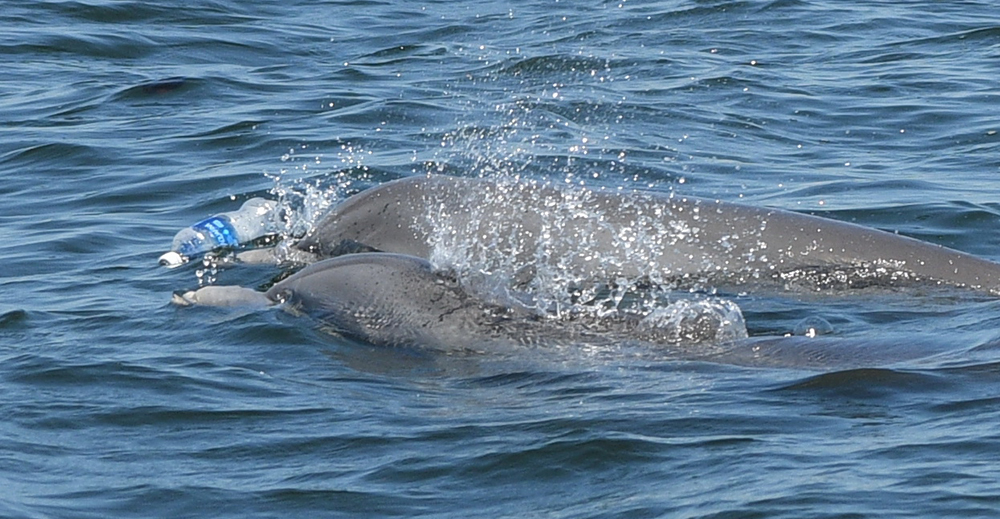
Phthalates — used to make plastics flexible and more durable and as solvents and stabilizers — have been nicknamed the “everywhere chemical” because they’re so widespread in our daily lives. These chemicals, which are easily released as plastics break down, are found in every-thing from PVC pipes, to food packaging and even cosmetics and perfumes. Exposure is so common that more than 95 percent of humans have detectible levels in their urine.
Although phthalate exposure is also common among dolphins in Sarasota Bay, the sources for these exposures are currently unknown.
As part of a three-year project funded by the National Institutes of Health’s (NIH) National Institute of Environmental Health Sciences (NIEHS; Award No. 1R15ES034169-01), we’re investigating whether microplastic contamination in prey fish might be a source of phthalate exposure. We’re also looking for evidence of microplastic ingestion in Sarasota Bay dolphins and their common prey fish (for example, spot, Gulf toadfish, pigfish, pinfish, Atlantic threadfin herring). To do this, we collect gastric (stomach) and fecal samples from dolphins, as well as gastrointestinal tracts and muscle tissue from fish. Then we compare the microplastics found in dolphins to those identified in fish, looking at details such as color, type and texture. We’re also:
- Examining phthalate metabolite levels in dolphins and fish relative to individual particle abundance. This analysis will help us understand whether high quantities of ingested plastic are correlated with high concentrations of chemical plasticizers.
- Comparing the amount and type of microplastics in different parts of fish, for example, muscle/filet vs. gastrointestinal tract. This will help us understand the potential risks of microplastic exposure for people who eat seafood.
We’re currently also working on a retrospective study, funded by Sea Grant (NA22OAR4170655 – CFDA #11.417), to understand factors influencing phthalate exposure among Sarasota Bay dolphins and how phthalates might impact their health. This study has two main goals:
- Explore how climate events affect phthalate exposure and dolphin health. We’re looking at how events like storms, rainfall and red tides might change phthalate exposure levels and lead to problems like hormone imbalances, reproductive issues, abnormal growth and heart diseases.
- Understand where and how dolphins are exposed to phthalates. By analyzing long-term dolphin sighting data and studying where dolphins spend their time, we hope to identify areas of the Bay where dolphins might be at a higher risk of exposure.
To do this, we’re testing 202 urine samples from Sarasota Bay dolphins collected during health assessments during 1993 through 2024. We will compare phthalate levels across years, different areas where dolphins live and periods with major climate events. The research will help us understand how climate events increase the risk of chemical exposure and how that exposure can harm wildlife. For example, plastics and chemicals frequently reach the Bay in runoff from coastal and upland areas. It might be expected that excessive rain events would bring more phthalates to the Bay. Thanks to the Sarasota Dolphin Research Program’s long-term study of the local dolphin community, we have a rare opportunity to answer these important questions in a natural setting.
Read More About Dolphins and Plastics
Reducing Plastics and Phthalates in the Environment
Help Wild Dolphins and Other Marine Life by Reducing Plastics and Phthalates in Your Life More than 170 trillion plastic particles end up in our oceans annually where they impact marine life
Plastics in Rural and Urban Dolphins
Dolphins Living Near Urban Coastline Show More Frequent Exposure to Chemicals from Plastics than those in Rural Area New study compared concentrations of endocrine-disrupting compounds between dolphins from Sarasota Bay, Florida, and Barataria
Ftalatos y Delfines
¿Los cambios en los patrones climáticos expondrán a los delfines a más sustancias químicas? Un estudio en la bahía de Sarasota, Florida, tiene como objetivo comprender si el exceso de lluvias y las
Phthalates and Dolphins
Will Changing Weather Patterns Expose Dolphins to More Chemicals? Sarasota Bay, Florida, study aims to understand whether excess rainfall and red tides impact the concentration of chemical contaminants in dolphins
Microplastics Detected in Dolphin Breath
Every Breath They Take? New Study Suggests Dolphins are Inhaling Plastics A member of the SDRP research team holds a petri dish over a dolphin's blowhole to collect a breath
A Tangled Food Web
Paper Provides New Insights on How Microplastics are Moving From Prey to Predator A new research paper based on studies conducted in Sarasota Bay is providing insights on how microplastics are moving
Stow it! Don’t Throw It!
Creating Monofilament Collectors to Help Save Dolphins from Entanglement Did you know that monofilament fishing line can take up to 600 years to decompose and that it
Plastic and Plastic Compounds in Dolphins
Studying the Impacts of Plastics and Plastic Compounds in Sarasota Bay Dolphins The oceans are estimated to contain more than 170 trillion plastic particles — with more
Dolphins and Microplastics
Study Finds Evidence that Dolphins are Ingesting Microplastics A new study in the peer-reviewed journal Frontiers in Marine Science has found evidence that members of the Sarasota Bay dolphin community are inadvertently ingesting
Join Our Marine Debris Team
One of the simplest ways to help wild dolphins — and all other marine life — is to make sure you’re not leaving plastics or other trash in our waterways or allowing garbage to
Research Publications
Dziobak MK, Curtin T, Wells RS, Takeshita R, Smith CR, Zolman E, Toms CN, Allen RF and Hart LB (2025) Comparing phthalate exposure between bottlenose dolphins (Tursiops truncatus) residing in urban and rural environments. Front. Mar. Sci. 12:1554075. doi: 10.3389/fmars.2025.1554075
Dziobak, M., Fahlman, A., Wells, R.S., Takeshita, R., Smith, C., Gray, A., Weinstein, J., and L.B. Hart. 2024. First evidence of microplastic inhalation among free-ranging bottlenose dolphins (Tursiops truncatus). PLOS One. https://doi.org/10.1371/journal.pone.0309377
Conger, E.; Dziobak, M.; Berens McCabe, E.J.; Curtin, T.; Gaur, A.; Wells, R.S.; Weinstein, J.E.; Hart, L.B. An Analysis of Suspected Microplastics in the Muscle and Gastrointestinal Tissues of Fish from Sarasota Bay, FL: Exposure and Implications for Apex Predators and Seafood Consumers. Environments 2024, 11, 185. https://doi.org/10.3390/environments11090185
Hart, L.B.; Dziobak, M.; Wells, R.S.; Berens McCabe, E.; Conger, E.; Curtin, T.; Knight, M.; Weinstein, J. Plastic, It’s What’s for Dinner: A Preliminary Comparison of Ingested Particles in Bottlenose Dolphins and Their Prey. Oceans 2023, 4, 409–422. https://doi.org/10.3390/oceans4040028
Dziobak, M.K.; Wells, R.S.; Pisarski, E.C.; Wirth, E.F.; Hart, L.B. A Correlational Analysis of Phthalate Exposure and Thyroid Hormone Levels in Common Bottlenose Dolphins (Tursiops truncatus) from Sarasota Bay, Florida (2010–2019). Animals 2022, 12, 824. https://doi.org/10.3390/ani12070824
Dziobak, M.K.; Balmer, B.C.; Wells, R.S.; Pisarski, E.C.; Wirth, E.F.; Hart, L.B. Temporal and Spatial Evaluation of Mono(2-ethylhexyl) Phthalate (MEHP) Detection in Common Bottlenose Dolphins (Tursiops truncatus) from Sarasota Bay, Florida, USA. Oceans 2022, 3, 231–249. https://doi.org/10.3390/oceans3030017
Dziobak, M. K., Wells, R. S., Pisarski, E. C., Wirth, E. F., & Hart, L. B. (2021). Demographic assessment of mono(2-ethylhexyl) phthalate (MEHP) and monoethyl phthalate (MEP) concentrations in common bottlenose dolphins (Tursiops truncatus) from Sarasota Bay, FL, USA. GeoHealth, 5, e2020GH000348. https://doi.org/10.1029/2020GH000348
Hart LB, Dziobak MK, Pisarski EC, Wirth EF, Wells RS (2020) Sentinels of synthetics – a comparison of phthalate exposure between common bottlenose dolphins (Tursiops truncatus) and human reference populations. PLoS ONE 15 (10): e0240506. https://doi.org/10.1371/journal. pone.0240506
Hart, L. B., Beckingham, B., Wells, R. S., Alten Flagg, M., Wischusen, K., Moors, A., et al. (2018). Urinary phthalate metabolites in common bottlenose dolphins (Tursiops truncatus) from Sarasota Bay, FL, USA. GeoHealth, 2. https://doi.org/10.1029/2018GH000146


